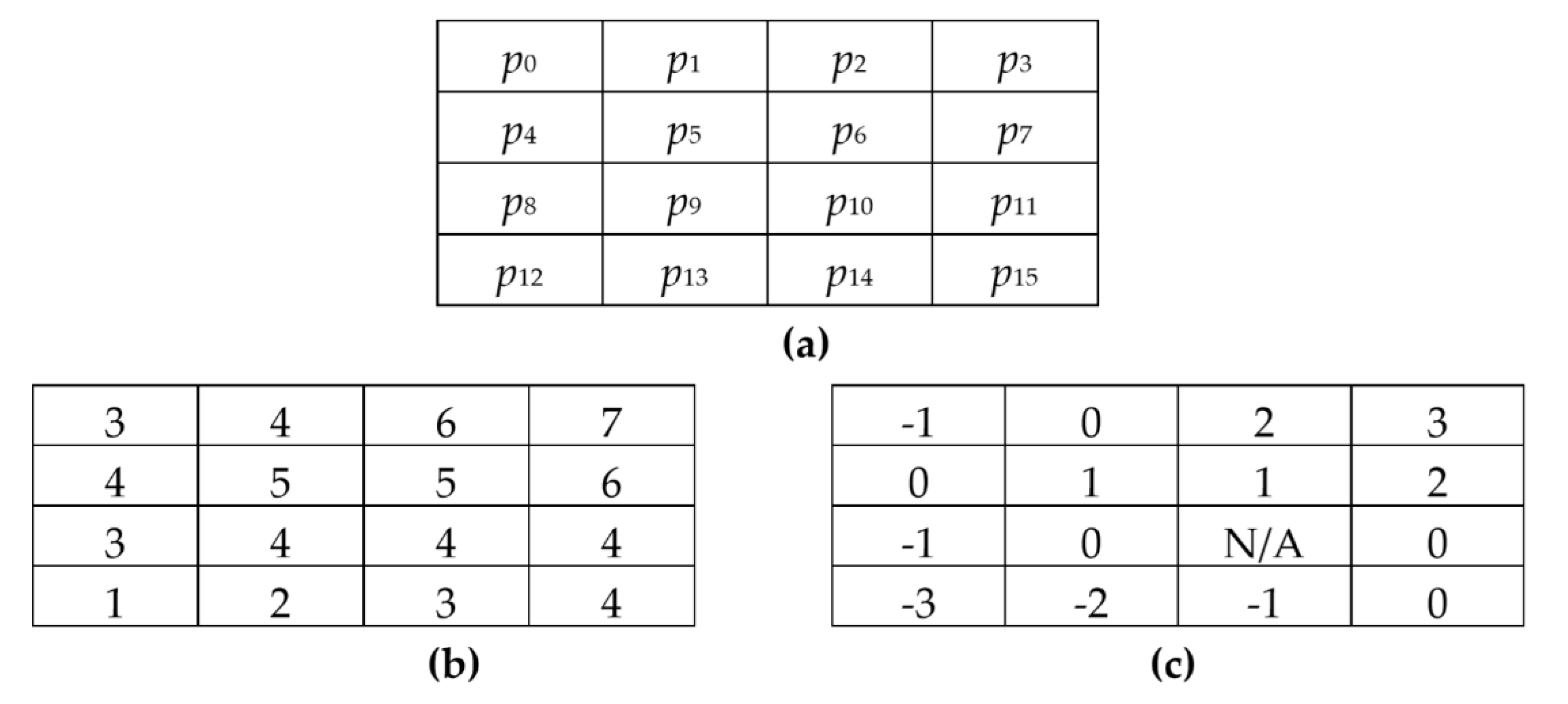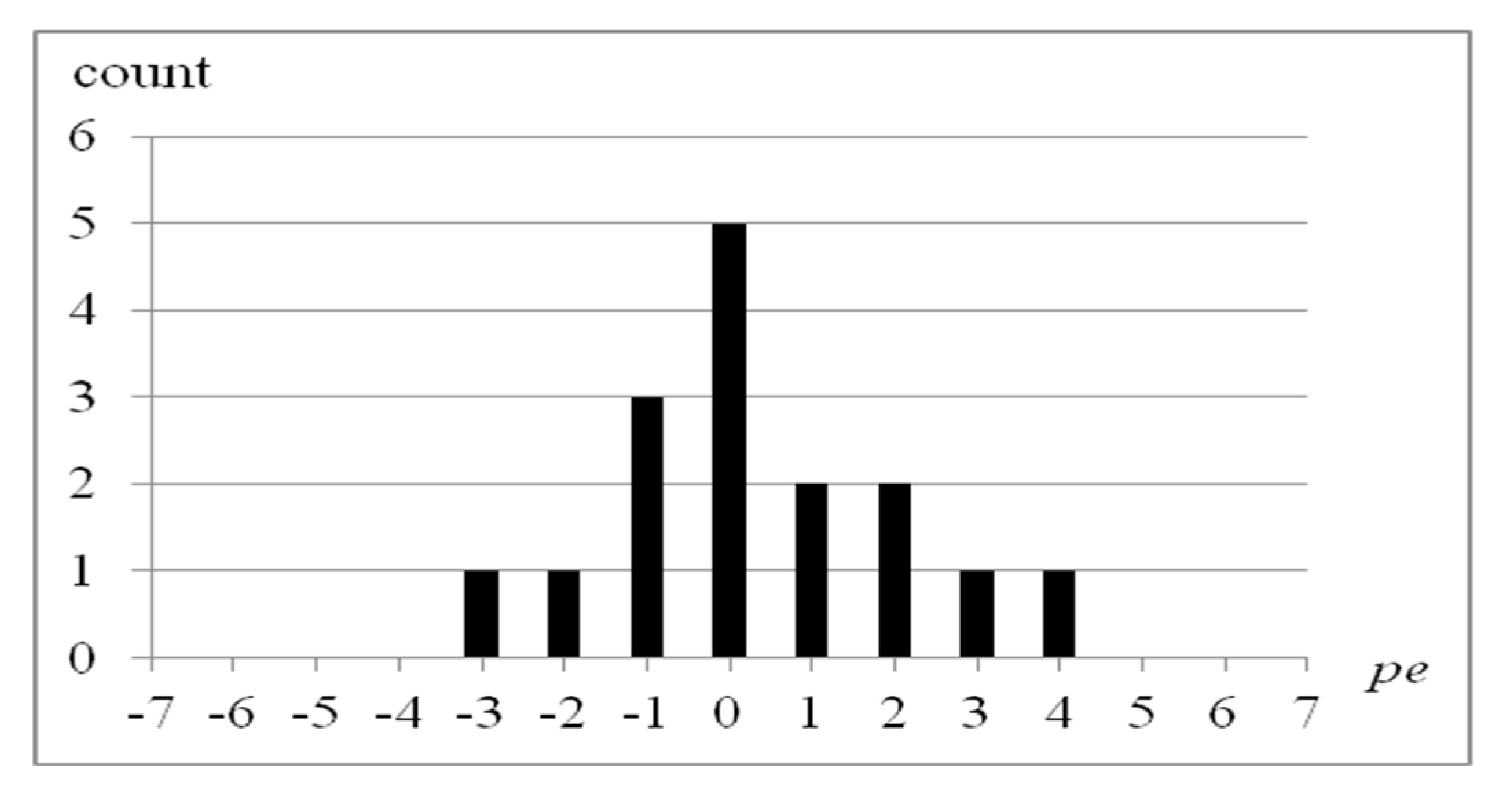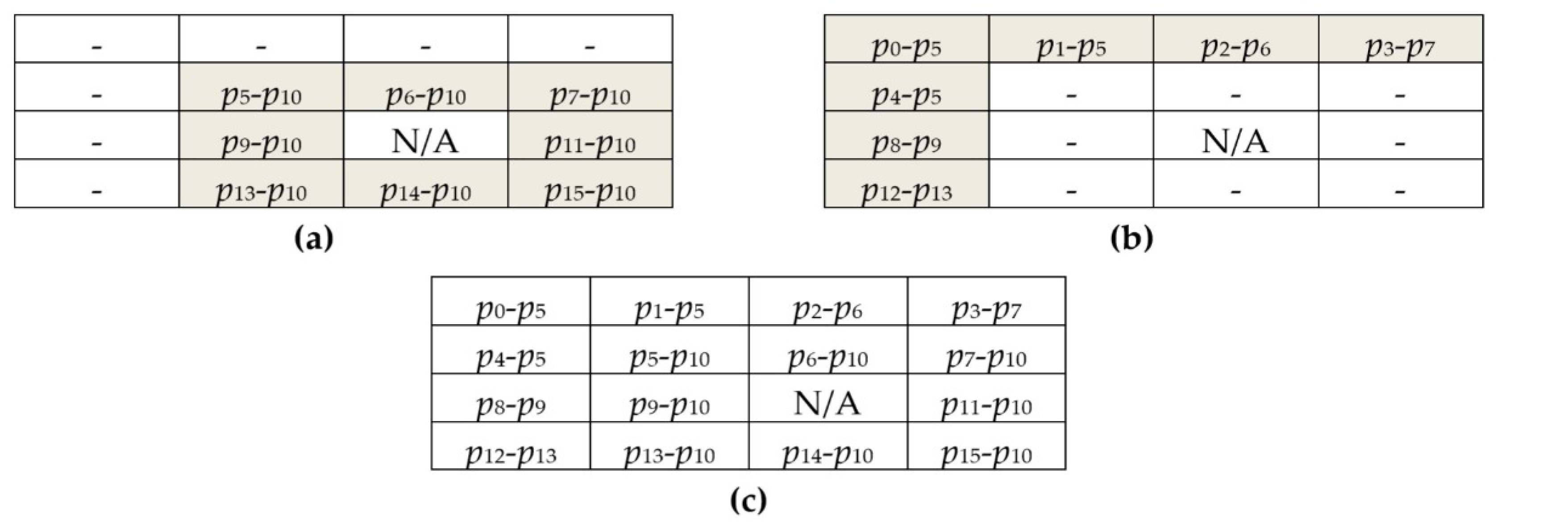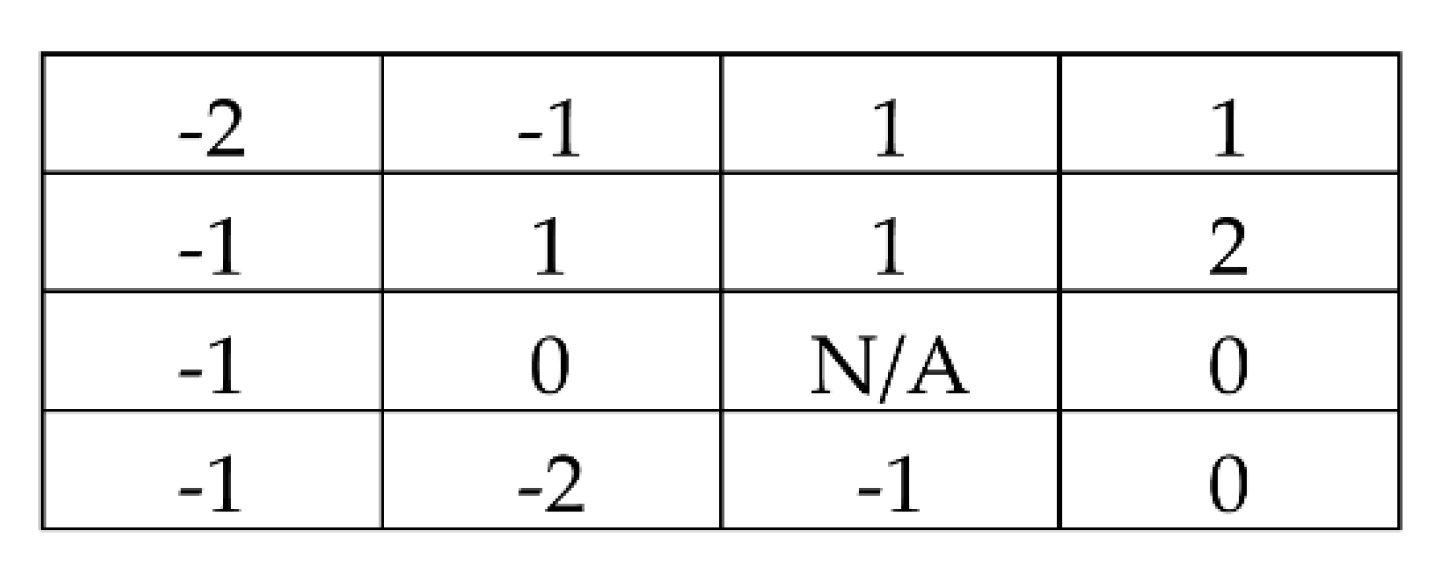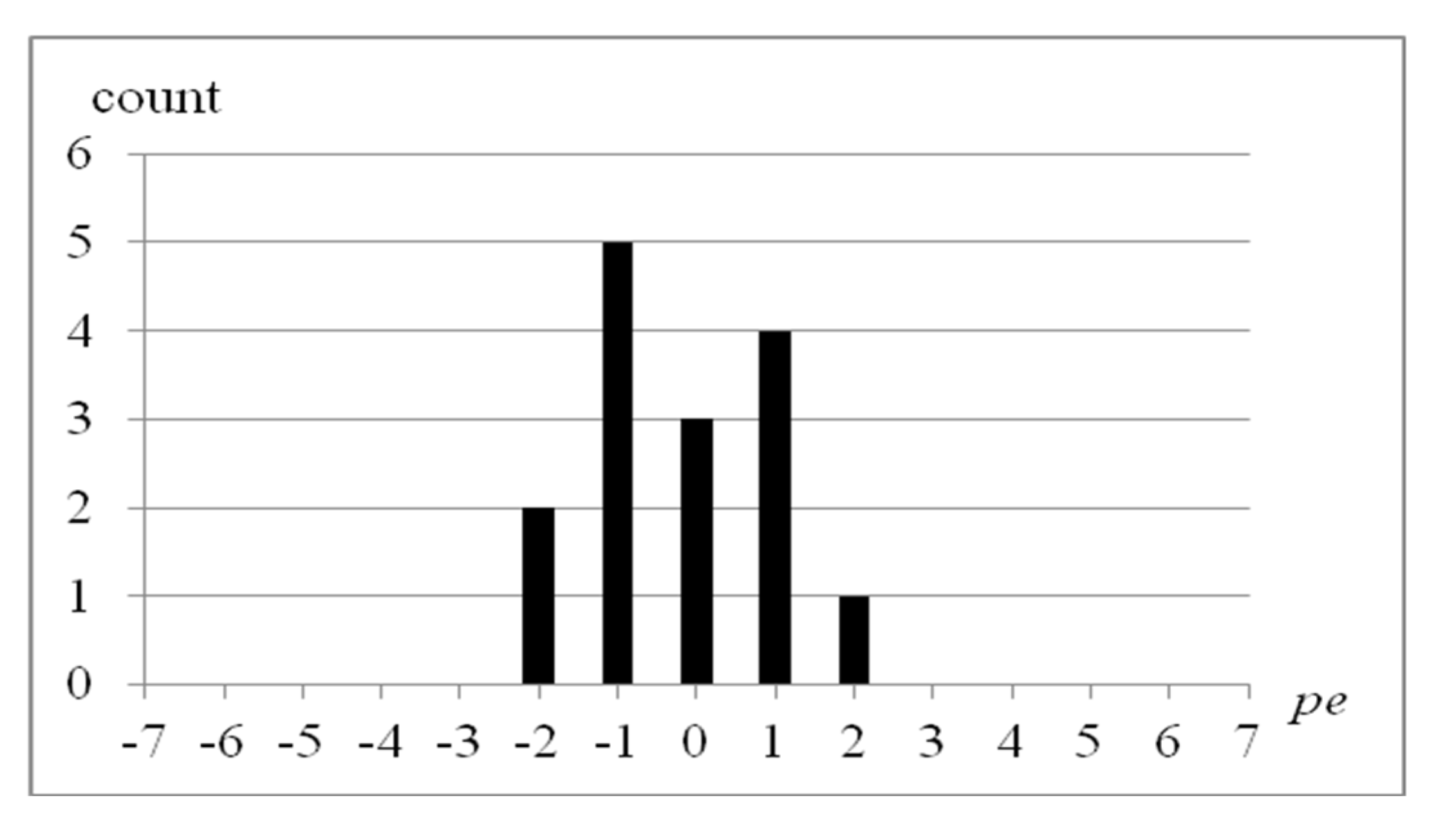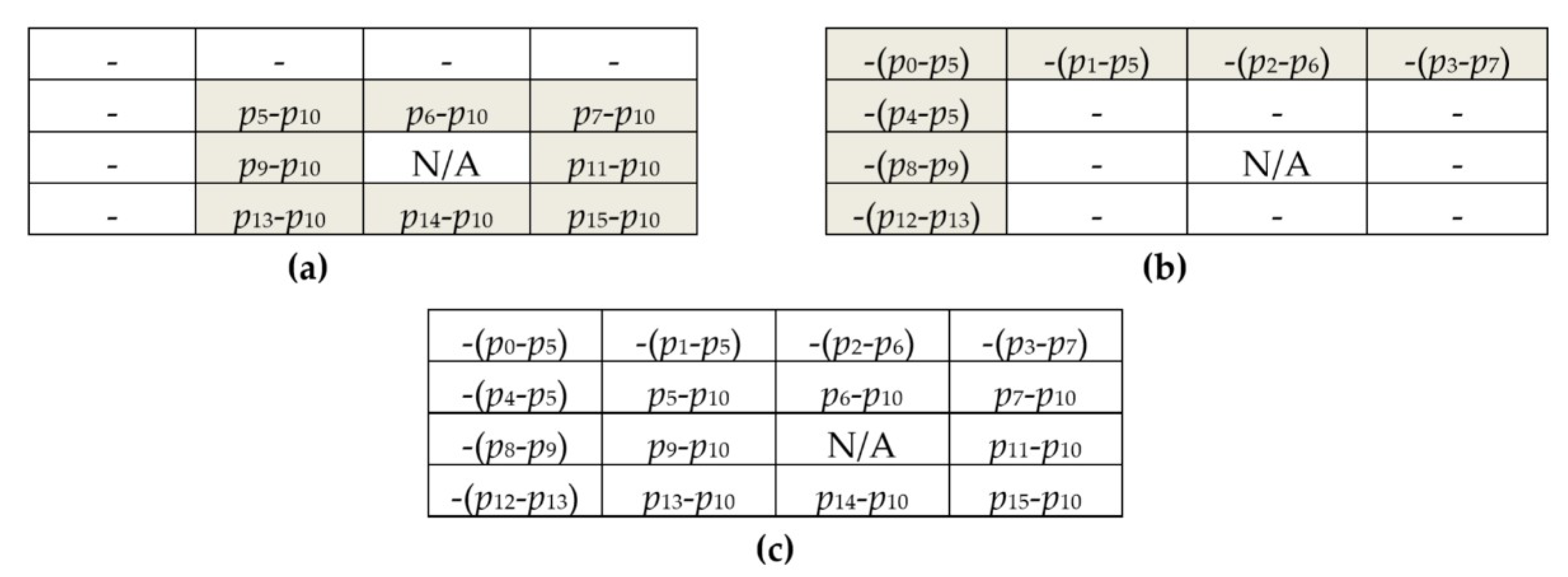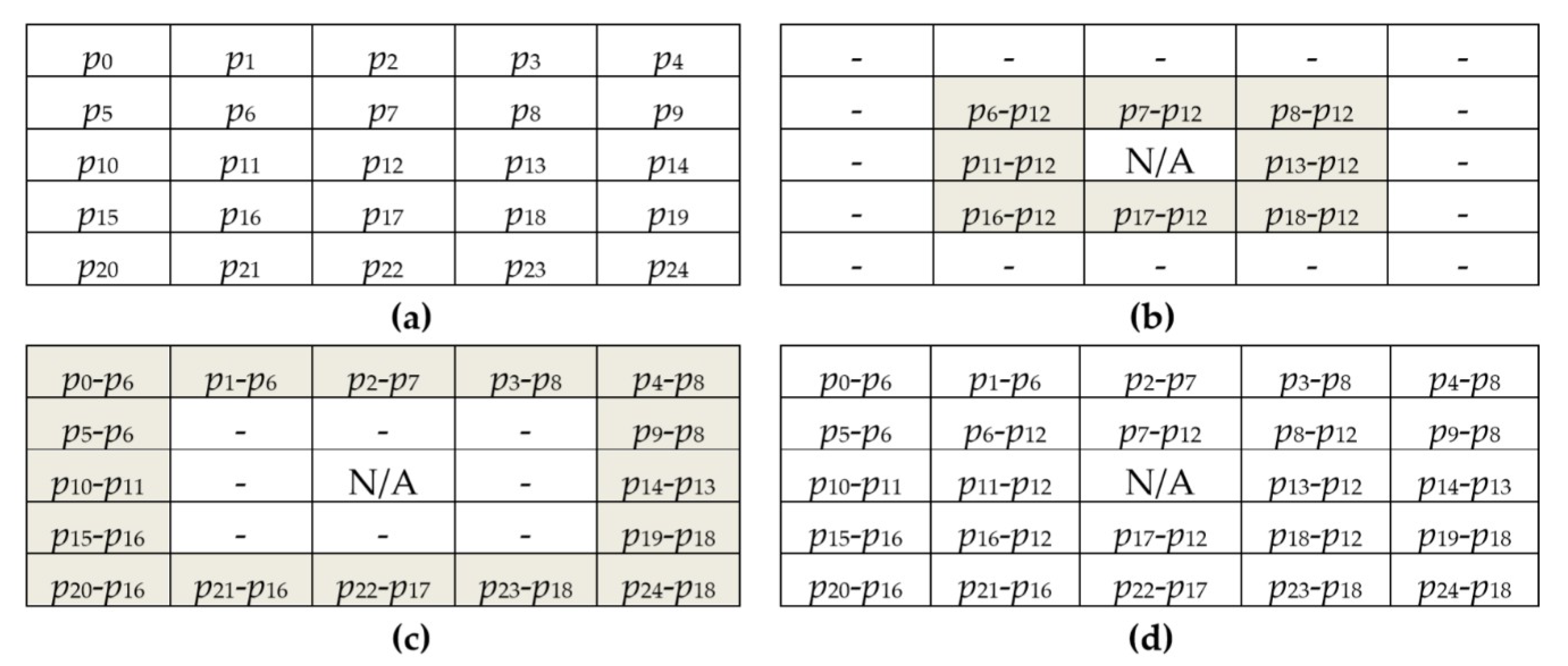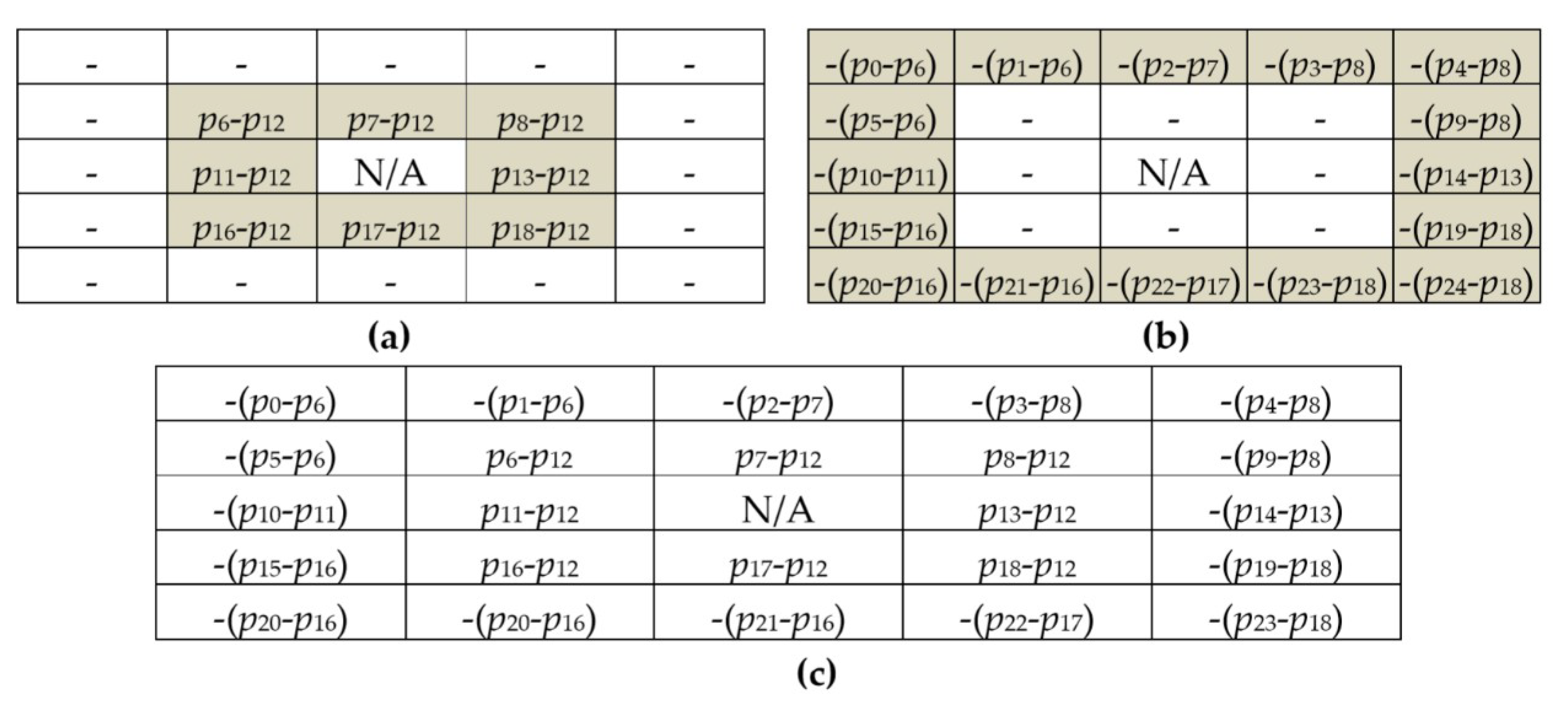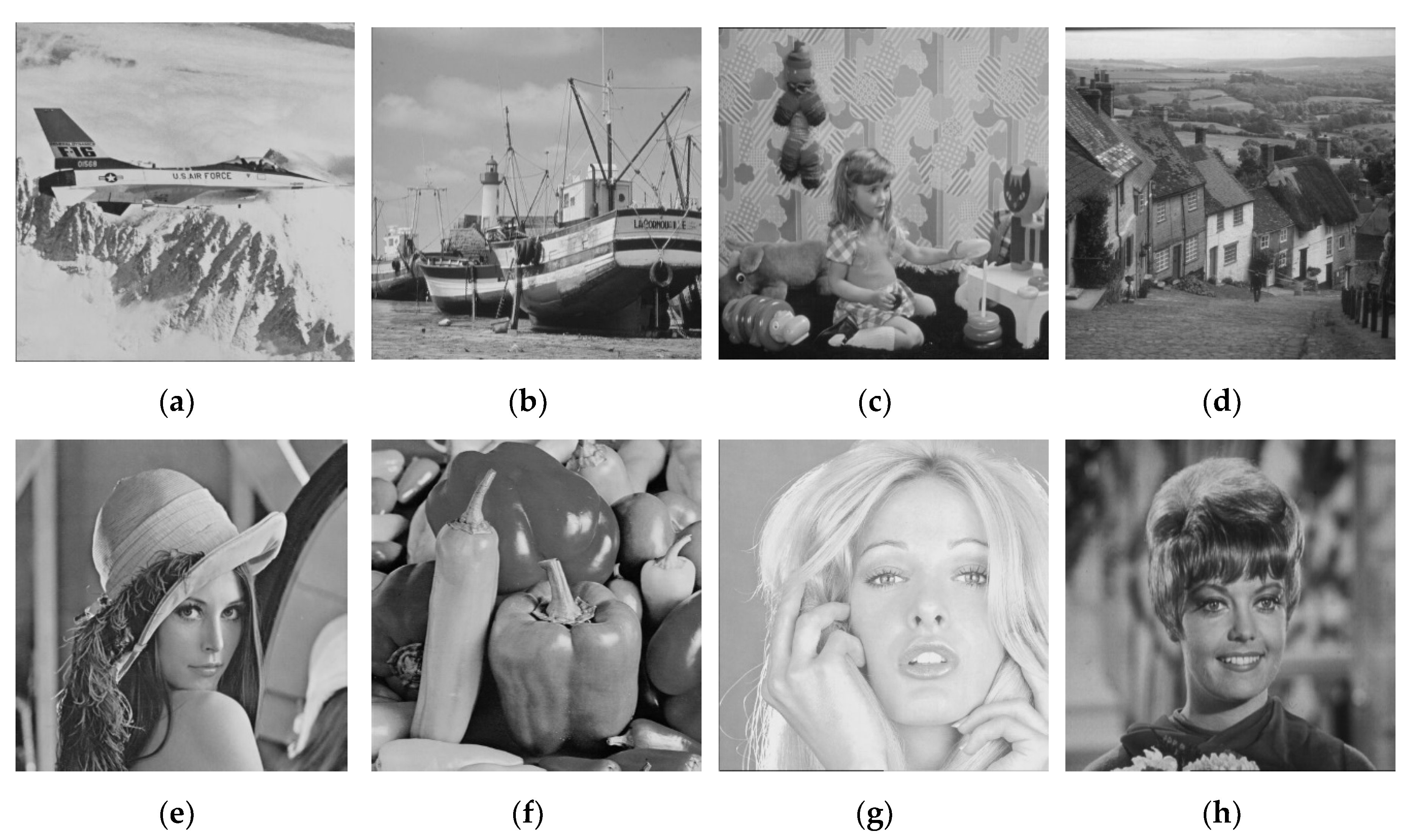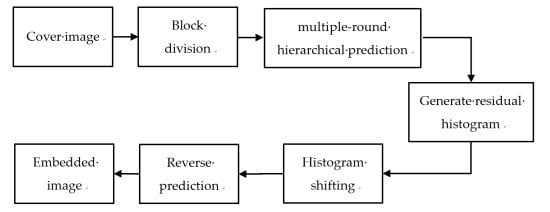1. Introduction
The data hiding techniques are generally classified into two categories: irreversible data hiding techniques [
1,
2,
3,
4,
5,
6,
7] and reversible data hiding techniques [
8,
9,
10,
11,
12]. In the reversible data hiding technique, secret data can be extracted and the original cover image can be recovered simultaneously. That is why the reversible data hiding techniques are often called the lossless data hiding techniques. Two main approaches for developing reversible data hiding techniques are the difference expansion (DE) [
13,
14,
15,
16] and the histogram shifting (HS) [
17,
18,
19,
20,
21,
22,
23,
24,
25,
26,
27,
28,
29,
30,
31,
32] approaches. Boato et al. proposed a reversible data hiding scheme that combined the above two approaches in 2012 [
15].
In 2006, Ni et al. introduced the concept of the histogram shifting for reversible data hiding [
17]. The occurrences of all the possible pixel values in a cover image are calculated to generate the image histogram. Secret data are embedded into the pixels located at the peak points. Basically, the hiding capacity of HS equals the number of the pixels in the peak points used. More pairs of the peak and zero points are required in order to obtain a better hiding capacity while the maximum numbers of the pairs of the peak and zero points are less than or equal to 2 in most of the nature images.
To increase the hiding capacity of HS, several residual histogram shifting (RHS) techniques had been proposed [
18,
19,
20,
21,
22,
23,
24]. Different prediction strategies were introduced in these RHS techniques to increase the occurrences of the peak points in the residual image histogram. Among these RHS techniques, the block-based prediction residual histogram shifting (BPRHS) technique proposed by Tsai et al. increases the hiding capacity and resists against the error propagation by using the block-based linear prediction [
18]. The reversible data hiding techniques can be improved in order to protect the image integrity. The basic function of the image integrity protection technique is to detect the tamper areas of an image. Lo and Hu extended the BPRHS technique to protect the image integrity for image tamper detection [
25]. In addition to detecting the tamper areas, some image integrity protection techniques are capable of roughly recovering the tamper areas.
Those reversible data hiding techniques mentioned above focused on the digital images in raw data format [
17,
18,
19,
20,
21,
22,
23,
24]. With the increasing demand of privacy protection, the ability to embed information in an encrypted image is desired. In the literature, some reversible data hiding techniques for the encrypted images had been introduced [
26,
27,
28]. Some reversible data hiding techniques for the block truncation coding had been proposed [
29,
30,
31]. An HS-based technique for the compressed images of block truncation coding had been proposed [
29]; an RHS-based data hiding scheme had been introduced for the compressed images of the block truncation coding (BTC) [
30]. Furthermore, an edge-based quantization approach had been designed for adaptive block truncation coding [
31].
To improve the hiding capacity of BPRHS, Hu et al. proposed a cascading prediction approach, which utilizes a two-stage prediction mechanism with a fixed block size of 4 × 4 pixels [
32]. In the first stage prediction, a fixed reference pixel is used, and the other pixels are predicted based on the nearest neighbor rule (NNR). To improve the hiding capacity of BPRHS further and to maintain good image quality of the embedded image, this paper proposes an efficient residual histogram shifting technique. The proposed technique extends the previous work [
32] by using the multiple-round hierarchical prediction mechanism so that it can work on the images of various block sizes. Furthermore, the reference pixel of a block of
n ×
n pixels where
n is even can be selected adaptively to provide more flexibility. One of the four center pixels in each block can be selected to act as the reference pixel. According to the results, the hiding capacity and the embedded image quality are approximately the same when different reference pixels are used. The selection of reference pixel can provide additional security protection for data embedding. This paper is organized as follows. The review of the BPRHS technique is given in
Section 2.
Section 3 presents the proposed technique. Experimentation is conducted in
Section 4. Finally,
Section 5 concludes this paper.
2. Review on the BPRHS Technique
The BPRHS technique was proposed to increase the hiding capacity of the HS scheme [
18]. In the HS scheme, the image histogram is generated and used to embed the secret data. The hiding capacity of HS is limited by the occurrences of pixels located at the peak points of the image histogram. To improve the hiding capacity of HS, the residual image histogram of the prediction errors will be generated and used to hide the secret data in BPRHS.
First, the cover image is partitioned into non-overlapped image blocks of
n ×
n pixels. The center pixel in each block is selected as the reference pixel for block-based prediction. Except for the reference pixel, there are
n ×
n−1 pixels in each
n ×
n block. The prediction error (
pe) of each remaining pixel can be computed by Equation (1):
where,
rdp and
refp denote the remaining pixel and the reference pixel, respectively.
By sequentially executing the block-based prediction process of each image block, all the prediction errors are computed to generate the residual image histogram. Let pno denote the number of pairs for peak and zero points used for secret data embedding. These pno pairs of peak and zero points are searched from the residual image histogram. Then, secret data is embedded into the prediction errors located at the peak points, and the prediction errors between the peak and zero points are shifted accordingly. Finally, the reverse block-based prediction process is executed to generate the embedded image.
An example of block-based prediction for the 4 × 4 image block by using BPRHS with
pno = 2 is described as below. The position diagram of the pixels is given in
Figure 1a. In BPRHS,
p10 is taken as the reference pixel. The test image block of 4 × 4 pixels is listed in
Figure 1b. A total of 15 prediction errors of the test block using BPRHS are shown in
Figure 1c. Since there is no prediction error for the center pixel
p10, the corresponding prediction error of
p10 is marked as not available (N/A). The resultant residual image histogram of BPRHS is shown in
Figure 2. Two pairs of peak and zero points (0,−4) and (2,5) are searched from this residual image histogram. These two pairs of peak and zero points are used in the residual histogram shifting process to embed the secret data. The hiding capacity of the BPRHS is 7 bits when the
pno value is set to 2.
3. Proposed Technique
The goal of the proposed technique is to extend the hiding capacity of the BPRHS scheme when the block size is greater than 4 × 4. The proposed technique extends Hu’s scheme [
32] by using the multiple-round hierarchical prediction mechanism. In Hu’s scheme, a two-stage prediction mechanism with a fixed block size of 4 × 4 pixels was introduced. In the first stage prediction, a fixed reference pixel is used, and the other pixels are predicted based on the nearest neighbor rule (NNR). It is obvious that the reference pixel usually has a lower degree of similarity to the pixels which are far away from it when the block size increases. To increase the occurrences of the peak points in the residual image histogram, the hierarchical prediction mechanism is designed in the proposed technique. Two prediction models are designed in the multiple-round prediction mechanism.
3.1. Data Embedding
In the proposed technique, the cover image is partitioned into non-overlapping image blocks of
n ×
n pixels. Let
pno denote the number of pairs of peak and zero points used for secrete data embedding. The value of
pno is usually determined according to user’s requirement or the size of the embedded secret data. The multiple-round prediction mechanism is employed to sequentially process the image blocks in the order of left-to-right and top-to-bottom. For each block to be processed, the number of rounds (
rno) that will be used in the hierarchical prediction mechanism should be determined first. The number of rounds needed for an
n ×
n image block can be computed by Equation (2):
In case of the block size of 3 × 3, only one round of prediction is needed; two rounds are required for the block sizes of 4 × 4 and 5 × 5; three rounds are required in case of the block sizes of 6 × 6 and 7 × 7.
For each n × n block to be processed, the reference pixel in each block is to be determined. The value of n may be either odd or even so two possible cases can be found in determining the reference pixel of each block. First, the center pixel in the image block is taken as the reference pixel when n is odd. The same rule cannot be employed when n is even because four center pixels are found in each block. Only one of these four candidates can be selected as the reference pixel in the proposed technique. Recall that a fixed center pixel is selected as the reference pixel in BPRHS. In the proposed technique, the reference pixel can be adaptively selected by the user.
The index/indices
idx of the center pixel for an
n ×
n image block can be computed by Equation (3):
According to the above Equation, the index of the center pixel equals 12 when the block size is 5 × 5. The indices of the center pixels are 5, 6, 9, and 10 when the block size is set to 4 × 4. Among these four center pixels, one will be selected as the reference pixel in the prediction process.
This study proposes two models of error prediction. The first round of the prediction process is the same for both of the two prediction models. Once the reference pixel is determined, the first round is executed. The prediction error (
pe) of each directly adjacent pixel (
dap) to the reference pixel (
rp) is computed according to Equation (4):
where
dap and
rp denote the directly adjacent pixel and the reference pixel, respectively.
Let crno denote the current round number for block-based prediction. Initially, crno is set to 1. The first round of prediction mentioned above is first executed. Only 8 directly adjacent pixels of the reference pixel are processed. If rno is greater than 1, the succeeding rounds of the prediction process are executed. Otherwise, the prediction process stops.
In each succeeding round of the prediction,
crno is increased by 1. The remaining pixels adjacent to the pixels processed in the previous round are selected. The closest adjacent pixel of each selected pixel is taken as the reference pixel. Here, the reference pixel is adaptively determined for each selected pixel based on NNR. The prediction error of each selected pixel (
sp) to its nearest neighboring pixel (
nnp) can be computed according to Equation (5):
If crno is less than rno, the above process can be extended round by round until all the pixels in this block are processed.
The above process is also called the first prediction model.
Figure 3 depicts the first prediction model for 4 × 4 blocks. Here, the center pixel p
10 is taken as the reference pixel of the image block. In the first round of prediction, eight prediction errors shown in
Figure 3a of these directly adjacent pixels to the center pixel are computed. In the second round of the prediction process, the remaining seven prediction errors are computed as shown in
Figure 3b. Here, p
5 is taken as the reference pixel for
p0,
p1, and
p4. Besides,
p6,
p7,
p9, and
p13 are taken as the reference pixels for
p2,
p3,
p8, and
p12, respectively. The prediction errors of this block are shown in
Figure 3c.
Taking the test image block in
Figure 1b as an example, the prediction errors of this block by the proposed multiple-round prediction mechanism are shown in
Figure 4. A total of 15 prediction errors are generated by the proposed prediction mechanism for this 4 × 4 image block. The resultant residual image histogram of the prediction errors is shown in
Figure 5.
Following this example, two pairs of peak and zero points are searched by this residual image histogram. They are (−1,−3) and (1,3). The maximal value of pno equals 2 in this example. The hiding capacities of the proposed technique are 5 and 9 bits when pno values are set to 1 and 2, respectively.
In addition to the first prediction model, we design the second prediction model based on the first one. The first round of the prediction process for the second prediction model is the same as that of the first prediction one. The prediction error of each directly adjacent pixel to the reference pixel can be computed according to Equation (3).
If there exist some remaining pixels to be processed in the succeeding rounds, the prediction error of each selected pixel (
sp) to its nearest neighboring pixel (
nnp) is computed according to Equation (6):
Figure 6 depicts the second prediction model for the 4 × 4 block. Similarly, the center pixel
p10 is taken as the reference pixel of the image block. In the first round of the prediction process, eight prediction errors shown in
Figure 6a of these directly adjacent pixels to the center pixel are computed. In the second round of the prediction process, the remaining seven prediction errors are computed as shown in
Figure 6b. The prediction errors of this block are shown in
Figure 6c.
In
Figure 7 and
Figure 8, the two prediction models for the 5 × 5 image block are depicted, respectively. Two rounds of the prediction process are performed to generate the prediction errors for the pixels in the image block of 5 × 5 pixels. A total of 24 prediction errors are generated after the multiple-round prediction mechanism is executed. In fact, the proposed hierarchical prediction mechanism can be extended for the image blocks of
n ×
n pixels where
n is greater than 5.
When the prediction errors of each n × n image block are computed by using the multiple-round prediction mechanism, the occurrences of all the possible residual values are calculated to generate the residual image histogram. After the residual image histogram is constructed, pno pairs of peak and zero points are then searched from the residual image histogram. The hiding capacity of the image equals the sum of the occurrences of the residual values located at these peak points.
Secret data are then embedded into the residual values in the peak points and the prediction errors between the peak and zero points will be shifted accordingly. After the secret data are embedded into the residual values, the embedded image can be generated by performing the reverse multiple-round prediction mechanism.
3.2. Data Extraction
The goal of the data extraction procedure is to extract secret data from the embedded image. In addition, the original cover image will be recovered after the secret data is extracted. Before the data extraction procedure is performed, the values of some system parameters, such as W, H, n, pno, the pairs of peak and zero points, and the prediction model used should be available.
First, the selected linear prediction model used in the data embedding procedure is applied on the embedded image to generate the residual embedded-image. The prediction errors of the residual embedded-image are examined to extract the embedded secret data and to recover the original cover image.
To extract the secret data, the prediction errors in each n × n block is sequentially processed in the raster scanning order. If the prediction error pe is not within any pair of the peak and zero points, pe is kept unchanged. Otherwise, three cases are discussed for pe that is within one specific pair of peak point and zero point. In the first case, if pe is located at the peak point, 1-bit secret data valued at 1 is extracted and the value of pe is unchanged. In the second case, if the zero point is smaller than the peak point and pe is smaller than the peak point by 1, 1-bit secret data value 0 is extracted and the value of pe is replaced by the value of the peak point. If the zero point is greater than the peak point and pe is greater than the peak point by 1, 1-bit secret data value 0 is extracted and the value of pe is replaced by the value of the peak point. Lastly, the remaining prediction errors are shifted close to peak point by 1 and no secret data is extracted. By sequentially processing the residual blocks in the rater scanning order, the embedded secret data is extracted from the residual embedded-image. Meanwhile, the original cover image is recovered by performing reverse linear prediction of the selected prediction model on the reconstructed embedded-image.
4. Results
Our experiments are performed on a Window 10 computer with Intel Core i7 3.6 GHz CPU and 16 GB random access memory (RAM). The testing programs are implemented in Bloodshed Dev C++. In our experiments, eight grayscale images of 512 × 512 pixels, “Airplane”, “Boat’, “Girl”, “Goldhill”, “Lenna”, “Pepper”, “Tiffany”, and “Zelda” in
Figure 9, are used. These testing images are downloaded from the USC SIPI image database.
To measure the image quality of the embedded image, the mean square error (
MSE) among the cover image and the embedded image of
W ×
H pixels is defined as Equation (7):
where
oij and
eij denote the grayscale pixels in the cover image and the embedded image, respectively.
Besides, the peak signal-to-noise ratio (
PSNR) between the cover image and the embedded image is calculated by Equation (8):
Generally, PSNR is considered as an indication of image quality rather than a definitive computation. It is a common measure for evaluating image quality. A large PSNR value indicates that the difference between two given images is quite small.
The results of the hiding capacity of the proposed technique with the two prediction models when the block size is 4 × 4 are listed in
Table 1 and
Table 2, respectively. In the simulations, one of these four center pixels is selected as the reference pixel (
refp). The same hiding capacities are obtained in these two prediction models when
pno is set to 1. The average hiding capacities of 274,47.125, 273,41.125, 273,92, and 272,64 bits are achieved with
pno is set to 1 when the reference pixels are
p5,
p6,
p9, and
p10, respectively.
The second prediction model performs slightly better hiding capacity than the first one when pno is set to 2. The average hiding capacities of 511,55.25, 509,43.13, 509,57.75, and 510,05.875 bits are achieved when pno to 2 in the second prediction model, and the reference pixels are p5, p6, p9, and p10, respectively. The results indicate the best hiding capacity is achieved in the proposed technique when the reference pixel is p5.
Table 3 and
Table 4 list the results of the image quality of the first and second prediction models of the proposed technique when the block size is set to 4 × 4, respectively. Compared to the first prediction model, the second prediction model provides much better image quality when
pno is set to 1. According to the results in
Table 3, average
PSNR values of 49.230, 49.217, 49.298, and 49.268 dB are achieved by using the first prediction model when
pno is set to 1, and the reference pixels are
p5,
p6,
p9, and
p10, respectively. Compared to the first prediction model, average image quality gains of 2.291 dB, 2.307 dB, 2.229 dB, and 2.245 dB are achieved by using the second prediction model when
pno is set to 1, and the reference pixels are
p5,
p6,
p9, and
p10, respectively.
Compared to the first prediction model, slightly worse
PSNR values are obtained using the second prediction model when
pno is set to 2. Average
PSNR values of 47.772 dB, 47.769 dB, 47.760 dB, and 47.755 dB are achieved by using the first prediction model when
pno is set to 2, and the reference pixels are
p5,
p6,
p9, and
p10, respectively. According to the results in
Table 3 to
Table 4, it is shown that the best image quality is achieved in the proposed technique when the reference pixel is set to
p5.
Results of these two prediction models proposed in this paper when the block size is set to 5 × 5 are listed in
Table 5 and
Table 6, respectively. These two prediction models provide similar hiding capacities. Average hiding capacities of 287,00.875, 535,35.375, and 535,42.75 bits are achieved by the first prediction model when the
pno values are 1, 2, and 3, respectively.
Compared to the first prediction model, the second prediction model provides much higher PSNR values. Average PSNR values of 51.550 dB, 46.523 dB, and 46.523 dB are achieved by the second prediction model when the pno values are 1, 2, and 3, respectively. Compared to the result by first prediction model, average image quality gains of 3.227 dB, 0.056 dB, 0.056 dB are achieved by the second prediction model when the pno values are 1, 2, and 3, respectively.
The comparative techniques and the proposed technique are analyzed and shown in
Table 7. The average results of these techniques examined by eight test images are listed. HS and CM represent the histogram shifting technique [
17] and the comparative method [
32], respectively. BPRHS-4 × 4 and BPRHS-5 × 5 stand for the BPRHS with the block sizes of 4 × 4 and 5 × 5, respectively. PT1-4 × 4 and PT1-5 × 5 denote the proposed technique with the first prediction model when the block sizes are 4 × 4 and 5 × 5, respectively. PT2-4 × 4 and PT2-5 × 5 denote the proposed technique with the second prediction model when the block sizes are 4 × 4 and 5 × 5, respectively. It is shown that the hiding capacities of BPRHS-5 × 5 is less than those of BPRHS-4 × 4. This is because a fixed reference pixel in each block is used by BPRHS. The prediction error becomes inaccurate when the processed pixel is far away from the reference pixel.
However, this problem is not found in the proposed technique. According to the results reported in
Table 3,
Table 4,
Table 5 and
Table 6, it is shown that the hiding capacity of the proposed technique increases with the increments of the block size. This result indicates that the proposed multiple-round prediction mechanism indeed solves the problem that may occur when using BPRHS. Among these schemes, PS2-5 × 5 outperforms these comparative schemes.
According to the results, the proposed technique provides a better hiding capacity than HS and BPRHS. Compared to the results by HS and BPRHS, average hiding capacity gains of 427,78.125 and 4699.875 bits are achieved by the proposed technique when pno is set to 2, and the block size is set to 4 × 4, respectively. Good image quality of the embedded images is achieved by the proposed technique. From the results, average PSNR values of 51.768 dB and 47.772 dB are achieved by the proposed technique when the block size of 4 × 4, and the values of pno are set to 1 and 2, respectively.
In the data hiding techniques based on the histogram shifting technique, the value of pno and the pairs of peak and zero points should be stored additionally. If the overflow/underflow problem occurs, additional information is recorded so that the reversible property can be preserved. In the simulations demonstrated for comparative studies in this section, no overflow/underflow problem is encountered. That is due to the fact that the max number of pairs is set to 3.
A major problem of BPRHS is that the hiding capacity decreases with the increase of the block size. That is because a fixed reference pixel is used to generate the prediction for all the other pixels in BPRHS. This problem is solved by the multiple-round prediction mechanism in the proposed technique. The reference pixel is adaptively determined for each selected pixel based on the NNR in the multiple-round prediction mechanism. From the results, it is obvious that the use of the multiple-round prediction in the proposed technique compared to BPRHS achieves higher occurrences of the peak points in the residual histogram. Moreover, good visual quality of the embedded image is achieved by the proposed technique, as demonstrated from the experimental results.
